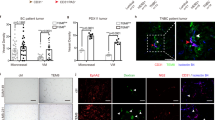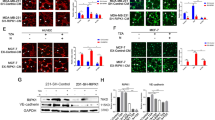Abstract
Vasculogenic mimicry (VM) refers to the unique capability of aggressive tumor cells to mimic the pattern of embryonic vasculogenic networks. In the study we demonstrated that CD133 expression was the highest in triple-negative (TN) breast cancer specimens. Importantly, VM showed statistical correlation with CD133+ expression. The presence of the close relationship between VM and CD133+ expression might be central for TN tumor relapse and progression. The TN breast cancer cell line, MDA-MB-231 cells developed a range of colony morphologies paralleling the holoclone, meroclone and paraclone morphologies produced by normal keratinocytes and other epithelial cancer cell lines when plated at clonal densities. Holoclone cells were capable of forming more colonies on soft agar than meroclone cells and paraclone cells, suggesting that holoclone cells had higher self-renew potential and might harbors cancer stem cells (CSCs) subpopulation. Strikingly, it was holoclone that displayed CD133+ phenotype and formed VM. In addition, holoclone acquired endothelial cell marker vascular endothelial-cadherin expression and upregulated VM mediators matrix metalloproteinase (MMP)-2 and MMP-9 expression. The subpopulation with holoclone morphology, CD133+ phenotype and CSCs characteristics might have the capacity of transdifferentiation and contributed to VM in TN breast cancer. The related molecular pathways may be used as novel therapeutic targets for the inhibition of angiogenesis and metastasis in TN breast carcinoma.
This is a preview of subscription content, access via your institution
Access options
Subscribe to this journal
Receive 50 print issues and online access
$259.00 per year
only $5.18 per issue
Buy this article
- Purchase on Springer Link
- Instant access to full article PDF
Prices may be subject to local taxes which are calculated during checkout







Similar content being viewed by others
Abbreviations
- 3D:
-
three dimensional
- CFE:
-
colony forming efficiency
- CSCs:
-
cancer stem cells
- MMPs:
-
matrix metalloproteinases
- PAS:
-
periodic acid-Schiff
- TN:
-
triple-negative
- VE:
-
vascular endothelial
- VM:
-
vasculogenic mimicry
References
Al Hajj M, Wicha MS, Benito-Hernandez A, Morrison SJ, Clarke MF . Prospective identification of tumorigenic breast cancer cells. Proc Natl Acad Sci USA 2003; 100: 3983–3988.
Zhong X, Li Y, Peng F, Huang B, Lin J, Zhang W et al. Identification of tumorigenic retinal stem-like cells in human solid retinoblastomas. Int J Cancer 2007; 121: 2125–2131.
Yan X, Ma L, Yi D, Yoon JG, Diercks A, Foltz G et al. A CD133-related gene expression signature identifies an aggressive glioblastoma subtype with excessive mutations. Proc Natl Acad Sci USA 2011; 108: 1591–1596.
Eaton CL, Colombel M, van der Pluijm G, Cecchini M, Wetterwald A, Lippitt J et al. Evaluation of the frequency of putative prostate cancer stem cells in primary and metastatic prostate cancer. Prostate 2010; 70: 875–882.
Florek M, Haase M, Marzesco AM, Freund D, Ehninger G, Huttner WB et al. Prominin-1/CD133, a neural and hematopoietic stem cell marker, is expressed in adult human differentiated cells and certain types of kidney cancer. Cell Tissue Res 2005; 319: 15–26.
Wright MH, Calcagno AM, Salcido CD, Carlson MD, Ambudkar SV, Varticovski L . Brca1 breast tumors contain distinct CD44+/CD24− and CD133+ cells with cancer stem cell characteristics. Breast Cancer Res 2008; 10: R10.
Shen R, Ye Y, Chen L, Yan Q, Barsky SH, Gao JX . Precancerous stem cells can serve as tumor vasculogenic progenitors. PLoS ONE 2008; 3: e1652.
Wang R, Chadalavada K, Wilshire J, Kowalik U, Hovinga KE, Geber A et al. Glioblastoma stem-like cells give rise to tumour endothelium. Nature 2010; 468: 829–833.
Sun T, Zhao N, Zhao XL, Gu Q, Zhang SW, Che N et al. Expression and functional significance of Twist1 in hepatocellular carcinoma: its role in vasculogenic mimicry. Hepatology 2010; 51: 545–556.
Zhang S, Zhang D, Sun B . Vasculogenic mimicry: current status and future prospects. Cancer Lett 2007; 7: 157–164.
Wang JY, Sun T, Zhao XL, Zhang SW, Zhang DF, Gu Q et al. Functional significance of VEGF-a in human ovarian carcinoma: role in vasculogenic mimicry. Cancer Biol Ther 2008; 7: 758–766.
Shevde LA, Metge BJ, Mitra A, Xi Y, Ju J, King JA et al. Spheroid-forming subpopulation of breast cancer cells demonstrates vasculogenic mimicry via hsa-miR-299–5p regulated de novo expression of osteopontin. J Cell Mol Med 2010; 14: 1693–1706.
Ping YF, Bian XW . Cancer stem cells switch on tumor neovascularization. Curr Mol Med 2011; 11: 69–75.
Dong J, Zhao Y, Huang Q, Fei X, Diao Y, Shen Y et al. Glioma stem/progenitor cells contribute to neovascularization via transdifferentiation. Stem Cell Rev 2011; 7: 141–152.
Monzani E, La Porta CA . Targeting cancer stem cells to modulate alternative vascularization mechanisms. Stem Cell Rev 2008; 4: 51–56.
Bruno S, Bussolati B, Grange C, Collino F, Graziano ME, Ferrando U et al. CD133+ renal progenitor cells contribute to tumor angiogenesis. Am J Pathol 2006; 169: 2223–2235.
Dean M . Cancer stem cells: redefining the paradigm of cancer treatment strategies. Mol Interv 2006; 6: 140–148.
Immervoll H, Hoem D, Sakariassen PØ, Steffensen OJ, Molven A . Expression of the ‘stem cell marker’ CD133 in pancreas and pancreatic ductal adenocarcinomas. BMC Cancer 2008; 8: 48.
Yeh CT, Kuo CJ, Lai MW, Chen TC, Lin CY, Yeh TS et al. CD133-positive hepatocellular carcinoma in an area endemic for hepatitis B virus infection. BMC Cancer 2009; 9: 324.
Carey LA, Dees EC, Sawyer L, Gatti L, Moore DT, Collichio F et al. The triple negative paradox: primary tumor chemosensitivity of breast cancer subtypes. Clin Cancer Res 2007; 13: 2329–2334.
Locke M, Heywood M, Fawell S, Mackenzie IC . Retention of intrinsic stem cell hierarchies in carcinoma-derived cell lines. Cancer Res 2005; 65: 8944–8950.
Li H, Chen X, Calhoun-Davis T, Claypool K, Tang DG . PC3 human prostate carcinoma cell holoclones contain self-renewing tumor-initiating cells. Cancer Res 2008; 68: 1820–1825.
Honeth G, Bendahl PO, Ringnér M, Saal LH, Gruvberger-Saal SK, Lövgren K et al. The CD44+/CD24− phenotype is enriched in basal-like breast tumors. Breast Cancer Res 2008; 10: R53.
Zhang K, Waxman DJ . PC3 prostate tumor-initiating cells with molecular profile FAM65Bhigh/MFI2low/LEF1low increase tumor angiogenesis. Mol Cancer 2010; 9: 319.
Hendrix MJ, Seftor EA, Meltzer PS, Gardner LM, Hess AR, Kirschmann DA et al. Expression and functional significance of VE-cadherin in aggressive human melanoma cells: role in vasculogenic mimicry. Proc Natl Acad Sci USA 2001; 98: 8018–8023.
Seftor EA, Meltzer PS, Schatteman GC, Gruman LM, Hess AR, Kirschmann DA et al. Expression of multiple molecular phenotypes by aggressive melanoma tumor cells: role in vasculogenic mimicry. Crit Rev Oncol Hematol 2002; 44: 17–27.
Ricci-Vitiani L, Pallini R, Biffoni M, Todaro M, Invernici G, Cenci T et al. Tumour vascularization via endothelial differentiation of glioblastoma stem-like cells. Nature 2010; 468: 824–828.
Liu WB, Xu GL, Jia WD, Li JS, Ma JL, Chen K et al. Prognostic significance and mechanisms of patterned matrix vasculogenic mimicry in hepatocellular carcinoma. Med Oncol 2010; 28 (Suppl 1): S228–S238.
Chen LX, He YJ, Zhao SZ, Wu JG, Wang JT, Zhu LM et al. Inhibition of tumor growth and vasculogenic mimicry by curcumin through down-regulation of the EphA2/PI3K/MMP pathway in a murine choroidal melanoma model. Cancer Biol Ther 2011; 11: 229–235.
Shevde LA, Metge BJ, Mitra A, Xi Y, Ju J, King JA et al. Phosphoinositide 3–Kinase Regulates Membrane Type 1-Matrix Metalloproteinase (MMP) and MMP-2 Activity during Melanoma Cell Vasculogenic Mimicry. J Cell Mol Med 2010; 14: 1693–1706.
Acknowledgements
This work was partly supported by a Grant from Key project of the National Natural Science Foundation of China (No. 30830049), the International Cooperation project of China-Sweden (No. 09ZCZDSF04400), the National Natural Science Foundation of China (No. 81172046 and No. 81173091) and the 973 Program from the Ministry of Science and Technology of China (No. 2009CB918903).
Author information
Authors and Affiliations
Corresponding author
Ethics declarations
Competing interests
The authors declare no conflict of interest.
Rights and permissions
About this article
Cite this article
Liu, T., Sun, B., Zhao, X. et al. CD133+ cells with cancer stem cell characteristics associates with vasculogenic mimicry in triple-negative breast cancer. Oncogene 32, 544–553 (2013). https://doi.org/10.1038/onc.2012.85
Received:
Revised:
Accepted:
Published:
Issue Date:
DOI: https://doi.org/10.1038/onc.2012.85
Keywords
This article is cited by
-
IFITM3 promotes glioblastoma stem cell-mediated angiogenesis via regulating JAK/STAT3/bFGF signaling pathway
Cell Death & Disease (2024)
-
Comprehensive Review on the Effect of Stem Cells in Cancer Progression
Current Tissue Microenvironment Reports (2024)
-
ICAM2 initiates trans-blood-CSF barrier migration and stemness properties in leptomeningeal metastasis of triple-negative breast cancer
Oncogene (2023)
-
Tumor-expressed B7-H3 promotes vasculogenic mimicry formation rather than angiogenesis in non-small cell lung cancer
Journal of Cancer Research and Clinical Oncology (2023)
-
Long non-coding RNAs in breast cancer stem cells
Medical Oncology (2023)



